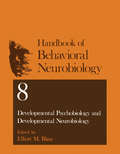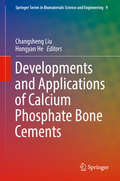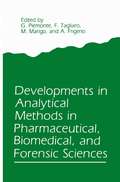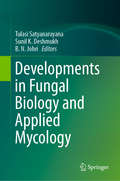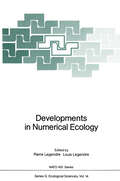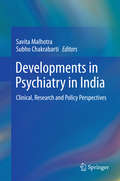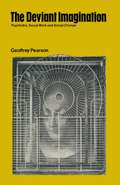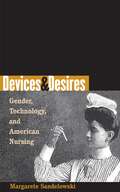- Table View
- List View
Developmental Psychobiology and Developmental Neurobiology: (pdf) (Handbooks of Behavioral Neurobiology #8)
by Elliott M. BlassDevelopmental Psychopathology: Concepts, Methods, and Findings
by Jim StevensonThis book addresses the question of whether or not behavioural differences between children can be most appropriately characterised by dimensions of psychological problems or by categorical diagnoses. It describes the concepts and methods that have been developed and applied within developmental psychopathology using this dimensional approach. The book reviews evidence on the interplay between genes and the environment in influencing internalising problems, externalising problems, Attention Deficit Hyperactivity Disorder (ADHD) and Autism Spectrum Disorder (ASD), and on the hierarchical factor structure underlying these behavioural dimensions. It provides an appraisal of the state of knowledge on the longer-term sequelae of these problems and on the efficacy of treatments that have been developed for them.Key areas of coverage include:Multivariate data analytic methods for investigating behavioural differences (e.g., path analysis, cluster analysis, structural equation modelling, network analysis) and their associated theoretical frameworks (e.g., hierarchical factor models).Methods to investigate the biology of behavioural differences (e.g., quantitative and molecular genetics, epigenetics, and brain imaging).The design of research studies that can test most directly for causality (i.e., randomised controlled trials) and others that can estimate plausible causal relationships from associations and correlations.Reviews of studies that have applied these methods to understand the developmental course of internalising and externalising behaviours and the neurodevelopmental problems of Attention Deficit Hyperactivity Disorder (ADHD) and Autism Spectrum Disorder (ASD). Developmental Psychopathology is an essential reference for researchers, professors, and graduate students as well as clinicians and other professionals in developmental psychology, clinical child and school psychology, child and adolescent psychiatry, paediatrics, clinical social work, public health, educational psychology, and all related disciplines.
Developmental Speech-Language Training through Music for Children with Autism Spectrum Disorders: Theory and Clinical Application
by Hayoung A. LimThe complete guide to Dr. Lim's highly effective 'Developmental Speech-Language Training through Music' (DSLM). It covers a theoretical foundation, the latest research, clinical implications of DSLM protocols, explanations of specific interventions and the application of DSLM to Applied Behavior Analysis (ABA) Verbal Behavior (VB) approaches.
Developmental Toxicology: Methods and Protocols (Methods in Molecular Biology #889)
by Craig Harris and Jason M. HansenThe discipline of developmental toxicology is an integration of concepts, models, and methodologies based heavily on the superimposition of toxicology principles upon the science of developmental biology. The science of developmental toxicology also borrows from other research areas that are concerned with regulation of cell growth, migration, differentiation and cell death, as such are central to the study of stem cells, cancer, and chronic diseases. In Developmental Toxicology: Methods and Protocols expert researchers in the field detail many of the methods which are now commonly used to study developmental toxicology highlighting the evolution of methods from classical teratology approaches to the dynamic, state-of-the-art molecular methods, systems biology, and next generation models and procedures. Written in the highly successful Methods in Molecular Biology™ series format, chapters include introductions to their respective topics, lists of the necessary materials and reagents, step-by-step, readily reproducible laboratory protocols, and key tips on troubleshooting and avoiding known pitfalls. Authoritative and practical, Developmental Toxicology: Methods and Protocols is a valuable resource to those planning experiments to investigate consequences of environmental, nutritional, or chemical effects caused during development.
Developmental Toxicology
by Deborah K. Hansen Barbara D. AbbottHighlighting latest advances in genetics and biochemistry, the completely revised Third Edition reviews the field from basic science, clinical, epidemiological, and regulatory perspectives. Contributions from top opinion leaders in the field bring together developments in molecular embryology and cell biology as they apply to problems in developmen
Developmental Toxicology: Methods and Protocols (Methods in Molecular Biology #1965)
by Jason M. Hansen Louise M. WinnThis thorough edition explores numerous methodological approaches that can be extremely informative for our understanding of the developmental toxicant mechanisms, characterization of developmental outcomes, and development of potential interventions that are clinically relevant. Presenting both staple and state-of-the-art approaches, the book focuses on numerous cellular models (induced pluripotent stem cells, neural crest culture, etc.), some less frequently used but important animal models (chick, zebrafish), in vitro approaches using whole embryos (rat, mouse and rabbit), and specific outcome methodologies to assess changes on the morphological to molecular level. Written for the highly successful Methods in Molecular Biology series, chapters include the kind of detail and expert implementation advice that allows for smooth processes in the lab. Authoritative and practical, Developmental Toxicology: Methods and Protocols, Second Edition serves as an ideal aid to support further investigation into the specific mechanisms and outcomes of developmental exposures.
Developmental Toxicology
by Keith SnellSince the 1930s and the work of Hale and Warkany on birth defects produced by variations in dietary vitamin A, it has been recognised that the developing fetus is particularly vulnerable to adverse influences in the environment. . Studies of malformations at birth remained largely in the hands of paediatricians who, for instance, quickly established the con nection between rubella infection in early pregnancy and the birth of severely affected infants. However, it was through the tragic events of 1962, when dramatic increases in the incidence of phocomelia in newborn infants in Germany, the United Kingdom, Japan, and other countries were traced to the use of the apparently non-toxic sedative thalidomide by pregnant women, that toxicologists were brought face to face with the devastating possibility of chemically-induced developmental abnormalities. It had been shown earlier that chemotherapeutic agents could cause damage to the developing organism, but the absence of any known examples of drug-induced birth defects had produced an air of complacency which was reinforced by the lack of any specific regulatory requirements for safety evaluation in this area. The magnitude of the thalidomide tragedy, affecting some 10000 malformed children, was sufficient to cause an immediate, and some would say hasty, reaction by government drug regulatory agencies throughout the world to construct a test protocol which would detect potential teratogenic substances that might give rise to anatomical malformations.
Developments and Applications of Calcium Phosphate Bone Cements (Springer Series in Biomaterials Science and Engineering #9)
by Changsheng Liu Hongyan HeThis book presents a state-of-the-art review of the latest advances in developing calcium- phosphate bone cements and their applications. It covers the synthesis methods, characterization approaches, material modification and novel binders, as well as the fabrication technologies of calcium-phosphate-based biomaterials in regenerative medicine and their clinical applications. It also highlights methodologies for fabricating scaffolds, biofunctional surfaces/interfaces and subsequently modulating the host response to implantable/injectable materials, and integrates a series of discussions and insights into calcium-phosphate cements and constructs in bone regenerative medicine. As such, the book not only covers the fundamentals but also opens new avenues for meeting future challenges in research and clinical applications.
Developments in Analytical Methods in Pharmaceutical, Biomedical, and Forensic Sciences
by G. Piemonte F. Tagliaro M. MarigoThe papers collected in this volume were presented at an International Conference that, with the same heading, was held at the Verona University, Italy, in June 1986. The meeting was organized by the Institute of Forensic Hedicine and the Laboratory of Medical Research of the University in cooperation with the Italian Group for Mass Spectrometry in Biochemistry and Medicine. The aim of the symposium was bringing together people, work ing in different branches of the wide field of modern analytical sciences, for promoting inter-disciplinary discussions and exchange of experiences. Actually it was felt that most of the analytical problems that very often have to be faced in quite different fields (chem istry, pharmacology, medicine, biology) have similar solutions, that could be made much easier by closer contac'cs among researches of these disciplines. Original papers and invited rewiews presented during the 3 days of the conference by leading experts gave an up-to-date outline of the modern analytical methods applied in pharmaceuti cal, biomedical and forensic sciences and a glimpse of the future perspectives.
Developments in Antibiotic Treatment of Respiratory Infections: Proceedings of the Round Table Conference on Developments in Antibiotic Treatment of Respiratory Infections in the Hospital and General Practice, held in the Kurhaus, Scheveningen, The Netherlands, June 15–16, 1980 (New Perspectives in Clinical Microbiology #4)
by R. Van FurthProceedings of the Round Table Conference on Developments in Antibiotic Treatment of Respiratory Infections in the Hospital and General Practice, held in the Kurhaus, Scheveningen, The Netherlands, June 15-16, 1980
Developments in Fungal Biology and Applied Mycology
by Tulasi Satyanarayana Sunil K. Deshmukh B. N. JohriThis book explores the developments in important aspects of fungi related to the environment, industrial mycology, microbiology, biotechnology, and agriculture. It discusses at length both basic and applied aspects of fungi and provides up-to-date laboratory-based data. Of the estimated three million species of fungi on Earth, according to Hawksworth and coworkers, more than 100,000 have been described to date. Many fungi produce toxins, organic acids, antibiotics and other secondary metabolites, and are sources of useful biocatalysts such as cellulases, xylanases, proteases and pectinases, to mention a few. They can also cause diseases in animals as well as plants and many are able to break down complex organic molecules such as lignin and pollutants like xenobiotics, petroleum and polycyclic aromatic compounds. Current research on mushrooms focuses on their hypoglycemic, anti-cancer, anti-pathogenic and immunity-enhancing activities. This ready-reference resource on various aspects of fungi is intended for graduate and post-graduate students as well as researchers in life sciences, microbiology, botany, environmental sciences and biotechnology.
Developments in Industrial Microbiology: Volume 1 Proceedings of the Sixteenth General Meeting of the Society for Industrial Microbiology Held at State College, Pennsylvania, August 30–September 3, 1959(pdf)
by Saul RichDevelopments in Medical Image Processing and Computational Vision (Lecture Notes in Computational Vision and Biomechanics #19)
by João Manuel R. S. Tavares Renato Natal JorgeThis book presents novel and advanced topics in Medical Image Processing and Computational Vision in order to solidify knowledge in the related fields and define their key stakeholders. It contains extended versions of selected papers presented in VipIMAGE 2013 – IV International ECCOMAS Thematic Conference on Computational Vision and Medical Image, which took place in Funchal, Madeira, Portugal, 14-16 October 2013. The twenty-two chapters were written by invited experts of international recognition and address important issues in medical image processing and computational vision, including: 3D vision, 3D visualization, colour quantisation, continuum mechanics, data fusion, data mining, face recognition, GPU parallelisation, image acquisition and reconstruction, image and video analysis, image clustering, image registration, image restoring, image segmentation, machine learning, modelling and simulation, object detection, object recognition, object tracking, optical flow, pattern recognition, pose estimation, and texture analysis. Different applications are addressed and described throughout the book, comprising: biomechanical studies, bio-structure modelling and simulation, bone characterization, cell tracking, computer-aided diagnosis, dental imaging, face recognition, hand gestures detection and recognition, human motion analysis, human-computer interaction, image and video understanding, image processing, image segmentation, object and scene reconstruction, object recognition and tracking, remote robot control, and surgery planning. This volume is of use to researchers, students, practitioners and manufacturers from several multidisciplinary fields, such as artificial intelligence, bioengineering, biology, biomechanics, computational mechanics, computational vision, computer graphics, computer science, computer vision, human motion, imagiology, machine learning, machine vision, mathematics, medical image, medicine, pattern recognition, and physics.
Developments in Numerical Ecology (Nato ASI Subseries G: #14)
by Pierre Legendre Louis LegendreFrom earlier ecological studies it has become apparent that simple univariate or bivariate statistics are often inappropriate, and that multivariate statistical analyses must be applied. Despite several difficulties arising from the application of multivariate methods, community ecology has acquired a mathematical framework, with three consequences: it can develop as an exact science; it can be applied operationally as a computer-assisted science to the solution of environmental problems; and it can exchange information with other disciplines using the language of mathematics. This book comprises the invited lectures, as well as working group reports, on the NATO workshop held in Roscoff (France) to improve the applicability of this new method numerical ecology to specific ecological problems.
Developments in Psychiatry in India: Clinical, Research and Policy Perspectives
by Savita Malhotra Subho ChakrabartiThe volume evaluates major developments in psychiatry in India from the 1950s, and highlights the areas where Indian psychiatry has contributed to the development of the subject worldwide. The chapters review international as well as Indian developments in psychiatry and its sub-specialities. A wide range of clinical, research and policy-related topics have been covered in the volume, which begins with an overview of the history of psychiatry in India, moving on to developments in various sub-specialities of psychiatry in the last 60 years or so. It then specifically discusses developments in psychology and psychodynamics, general adult and child psychiatry, substance use psychiatry, community psychiatry, liaison psychiatry, and other psychiatric sub-specialities. Developments in treatment, the status of training and service in psychiatry and legal issues related to the practice of psychiatry in India are also included. The contributors to this volume are nationally and internationally recognized experts in different areas of psychiatry. Most of them have had some association, or are currently associated, with the Department of Psychiatry at the Post Graduate Institute of Medical Education and Research, Chandigarh, India.
Developments in Statistical Evaluation of Clinical Trials
by Kees Van Montfort Johan Oud Wendimagegn GhideyThis book describes various ways of approaching and interpreting the data produced by clinical trial studies, with a special emphasis on the essential role that biostatistics plays in clinical trials.Over the past few decades the role of statistics in the evaluation and interpretation of clinical data has become of paramount importance. As a result the standards of clinical study design, conduct and interpretation have undergone substantial improvement. The book includes 18 carefully reviewed chapters on recent developments in clinical trials and their statistical evaluation, with each chapter providing one or more examples involving typical data sets, enabling readers to apply the proposed procedures. The chapters employ a uniform style to enhance comparability between the approaches.
Developments in Statistical Modelling (Contributions to Statistics)
by Jochen Einbeck Hyeyoung Maeng Emmanuel Ogundimu Konstantinos PerrakisThis volume on the latest developments in statistical modelling is a collection of refereed papers presented at the 38th International Workshop on Statistical Modelling, IWSM 2024, held from 14 to 19 July 2024 in Durham, UK. The contributions cover a wide range of topics in statistical modelling, including generalized linear models, mixture models, regularization techniques, hidden Markov models, smoothing methods, censoring and imputation techniques, Gaussian processes, spatial statistics, shape modelling, goodness-of-fit problems, and network analysis. Various highly topical applications are presented as well, especially from biostatistics. The approaches are equally frequentist and Bayesian, a categorization the statistical modelling community has synergetically overcome. The book also features the workshop’s keynote contribution on statistical modelling for big and little data, highlighting that both small and large data sets come with their own challenges. The International Workshop on Statistical Modelling (IWSM) is the annual workshop of the Statistical Modelling Society, with the purpose of promoting important developments, extensions, and applications in statistical modelling, and bringing together statisticians working on related problems from various disciplines. This volume reflects this spirit and contributes to initiating and sustaining discussions about problems in statistical modelling and triggers new developments and ideas in the field.
Developments in T Cell Based Cancer Immunotherapies (Cancer Drug Discovery and Development)
by Paolo A. Ascierto David F. Stroncek Ena WangThis volume illustrates the salient aspects of cancer biology relevant to the successful implementation of immunotherapy. Topics include enhancement of antigen-specific immune responses by anti-cancer vaccines, modulation of the function of T cells within the tumor microenvironment, and the effects of genetic, epigenetic, developmental, and environmental determinants on T cell function. Other topics covered include the ex vivo expansion of T or other immune cells and their genetic modification or reprogramming to increase their ability to survive and expand when adoptively transferred back to the patients. Specific attention is devoted to the genetic manipulation of T cells through the introduction of re-directed T cell receptors, chimeric antibody receptors, and other genetic manipulation aimed at improving their effectiveness as anti-cancer agents. Furthermore, the revolutionary role of checkpoint inhibitors and their potential in combination with other immunotherapeutic approaches or with standard chemo and radiation therapy are extensively discussed.
Deviate: The Science of Seeing Differently
by Beau LottoWorld-renowned neuroscientist Beau Lotto reveals the truths of human perception and devises a cognitive toolkit for how to succeed in a world of uncertainty.Perception is the foundation of human experience, but few of us understand how our own perception works. By revealing the startling truths about the brain and perception, Beau Lotto shows that the next big innovation is not a new technology: it is a new way of seeing.In his first major book, Beau Lotto draws on over a decade of pioneering research to show how our brains play tricks on us. With an innovative combination of case studies and optical- and perception-illusion exercises, DEVIATE will revolutionise the way you see the world. With this new understanding of how the brain works and its perceptive trickery, we can apply these insights to every aspect of life and work. DEVIATE is not just an engaging look into the neuroscience of thought, behaviour and creativity: it is a call to action, enlisting readers in their own journey of self-discovery.
Device Therapy in Heart Failure (Contemporary Cardiology)
by William H. MaiselHeart failure affects over 5 million patients in the United States alone, and is a chronic and debilitating disease. While a number of pharmacologic therapies have shown varying degrees of effectiveness, many recent advances in the treatment of heart failure has focused on device based therapies. In Device Therapy in Heart Failure, William H. Maisel and a panel of authorities on the use and implementation of device based therapies provide a comprehensive overview of the current and developing technologies that are used to treat heart failure. Individual chapters provide an in-depth analysis of devices such as CRT’s and ICD’s, while broader topics such as the pathophysiology of heart failure and its current medical therapies are also discussed. Additional topics include Pacing and Defibrillation for Atrial Arrhythmias, Atrial Fibrillation Ablation, and Percutaneous Treatment of Coronary Artery Disease.
Devices and Designs: Medical Technologies in Historical Perspective (Science, Technology and Medicine in Modern History)
by C. Timmermann J. AndersonIn this volume, leading scholars in the history and sociology of medicine focus their attention on the material cultures of health care. They analyze how technology has become so central to medicine over the last two centuries and how we are coping with the consequences.
Devices And Desires: Gender, Technology, And American Nursing (pdf) (Studies In Social Medicine Ser.)
by Margarete SandelowskiDevices for Cardiac Resynchronization: Technologic and Clinical Aspects
by S. Serge Barold Philippe RitterHere is an essential text for cardiologists, heart surgeons, intensive care specialists and anyone interested in pacing. It is a comprehensive guide to contemporary devices used in the resynchronization of patients’ heartbeats. The treatment of congestive heart failure by implanted biventricular pacemakers, or cardiac resynchronization, has revolutionized the practice of implanting pacemakers and defibrillators. More cardiac resynchronization therapy devices than conventional pacemakers are now being implanted and the numbers are growing worldwide.
Devices for Mobility and Manipulation for People with Reduced Abilities
by Teodiano Bastos-Filho Dinesh Kumar Sridhar Poosapadi ArjunanThe development and application of assistive technology can help those with reduced abilities improve their quality of life and reduce their dependence on others. Written in layman's terms, Devices for Mobility and Manipulation for People with Reduced Abilities provides research and information on assistive technologies for non-technical people. Wh
